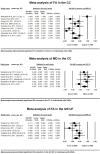Comparison of white matter integrity between autism spectrum disorder subjects and typically developing individuals: a meta-analysis of diffusion tensor imaging tractography studies
- PMID: 23876131
- PMCID: PMC3726469
- DOI: 10.1186/2040-2392-4-25
Comparison of white matter integrity between autism spectrum disorder subjects and typically developing individuals: a meta-analysis of diffusion tensor imaging tractography studies
Abstract
Background: Aberrant brain connectivity, especially with long-distance underconnectivity, has been recognized as a candidate pathophysiology of autism spectrum disorders. However, a number of diffusion tensor imaging studies investigating people with autism spectrum disorders have yielded inconsistent results.
Methods: To test the long-distance underconnectivity hypothesis, we performed a systematic review and meta-analysis of diffusion tensor imaging studies in subjects with autism spectrum disorder. Diffusion tensor imaging studies comparing individuals with autism spectrum disorders with typically developing individuals were searched using MEDLINE, Web of Science and EMBASE from 1980 through 1 August 2012. Standardized mean differences were calculated as an effect size of the tracts.
Results: A comprehensive literature search identified 25 relevant diffusion tensor imaging studies comparing autism spectrum disorders and typical development with regions-of-interest methods. Among these, 14 studies examining regions of interest with suprathreshold sample sizes were included in the meta-analysis. A random-effects model demonstrated significant fractional anisotropy reductions in the corpus callosum (P = 0.023, n = 387 (autism spectrum disorders/typically developing individuals: 208/179)), left uncinate fasciculus (P = 0.011, n = 242 (117/125)), and left superior longitudinal fasciculus (P = 0.016, n = 182 (96/86)), and significant increases of mean diffusivity in the corpus callosum (P = 0.006, n = 254 (129/125)) and superior longitudinal fasciculus bilaterally (P = 0.031 and 0.011, left and right, respectively, n = 109 (51/58)), in subjects with autism spectrum disorders compared with typically developing individuals with no significant publication bias.
Conclusion: The current meta-analysis of diffusion tensor imaging studies in subjects with autism spectrum disorders emphasizes important roles of the superior longitudinal fasciculus, uncinate fasciculus, and corpus callosum in the pathophysiology of autism spectrum disorders and supports the long-distance underconnectivity hypothesis.
Figures




References
LinkOut - more resources
Full Text Sources
Other Literature Sources

